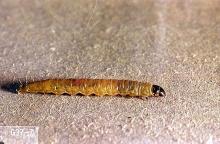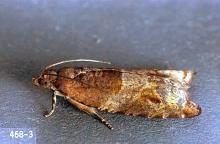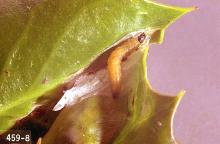Rhopobota naevana
Pest description and crop damage This insect overwinters in the egg stage on undersides of cranberry leaves. Larvae are greenish yellow with a shiny black head, and are 0.25 inch in length at maturity. First-brood larvae web and feed on new tip growth in late April or early May. Second-brood larvae web runner ends and damage berries and fruit buds for next year's crop. When injury is severe, vine tips look brown, as if scorched by fire, and berries shrivel. Larvae may enter berries. A third generation of moths may emerge in August and September. Moths of the second and third broods lay overwintering eggs.
Sampling and thresholds In late April, begin to monitor for larvae that have hatched from overwintering eggs by using a sweep net or by doing a visual sweep. A visual sweep consists of ten visual inspections of 2 square feet per acre. Treatment is recommended if one larva per sweep net or visual sweep is found. Control of the first larval hatch helps reduce the likelihood of large subsequent hatches. Pheromone traps are available to monitor flight activity of the moth stage. These are for developmental timing only and do not replace net or visual sweeps.
Management-chemical control: COMMERCIAL USE
- acetamiprid and novaluron (Cormoran) at 0.06 lb ai/A. PHI 1 day. Do not flood within 60 days of an application.
- acephate (Orthene 97 and Acephate 97UP) at 1.0 lb ai/A. PHI 75 or 90 days (check label). Do not apply during bloom; material is hazardous to bees. Do not exceed one application per crop season. Do not tank mix with other organophosphate insecticides.
- Bacillus thuringiensis (Crymax, DiPel DF, Biobit, Xentari and others)-Consult label for rate. PHI 0 days. Not effective for second generation larvae. Some formulations are OMRI-listed for organic use. Most effective when applied multiple times and in low gallonage against small caterpillars feeding on foliage. Scouting for early larval emergence is critical. Well-timed chemigation systems are critical for good efficacy (6 minutes or less rinse time). Thorough coverage is essential and repeat applications may be necessary. Caterpillars stop feeding after eating compounds but may take several (3 to 10) days to die. Use low-volume ground applications whenever possible to improve performance.
- bifenthrin (Fanfare EC) at 0.10 lb ai/A. PHI 30 days. Restricted use pesticide.
- carbaryl (Seven, several brands) at 1.0 to 2.0 lb ai/A. Products differ; check label for rate. PHI 7 days. Do not apply during bloom; carbaryl is hazardous to bees.
- chlorantraniliprole (Altacor, Altacor eVo) at 0.066 to 0.099 lb ai/A. PHI 1 day. Apply just prior to egg hatch or to small larvae. Repeat application 14 to 20 days later. Use high rate for moderate to heavy infestations.
- cyantraniliprole (Exirel) at 0.065 to 0.133 lb ai/A. PHI 14 days. Not tested against fireworm specifically, but effective against other lepidopteran pests. Highly toxic to bees.
- diazinon (several brands) at 2 lb ai/A. PHI 7 days. Do not apply to bloom; material is hazardous to bees. Restricted use pesticide.
- fenpropathrin (Danitol 2.4EC) at 0.3 to 0.4 lb ai/A. PHI 3 days. Do not apply during bloom. Restricted use pesticide.
- indoxacarb (Avaunt) at 0.11 lb ai/A. PHI 30 days (7 days for Avaunt evo). Hold water for at least one day. Material is hazardous to bees.
- methoxyfenozide (Intrepid and others) at 0.16 to 0.25 lb ai/A. PHI 14 days. Apply to small larvae. Repeat application 10 to 14 days later. Do not exceed 1 lb ai/A per crop season.
- novaluron (Rimon) at 0.08 lb ai/A. PHI 1 day.
- pyrethrin (several brands) at 0.01 to 0.05 lb ai/A. PHI 0 days. Apply to small larvae. PyGanic brand is OMRI-listed for organic use. Do not apply to bloom; material is hazardous to bees.
- spinetoram (Delegate) at 0.05 to 0.09 lb ai/A. PHI 21 days. Apply at egg hatch or to small larvae. Repeat applications should not be made less than 7 days apart. Do not exceed 6 applications per season. Do not apply to bloom; material is hazardous to bees for three hours following treatment.
- spinosad (Entrust)-Consult label for rate. PHI 21 days. Apply at egg hatch or to small larvae. Entrust is OMRI-listed for organic use. Do not apply to bloom; material is hazardous to bees for three hours following treatment.
- tebufenozide (Confirm) at 0.25 lb ai/A. PHI 30 days. Apply at first sign of larval infestation during first generation of the season; repeat application 7 to 10 days later. For second generation, apply at 10 to 20% egg hatch; repeat application 7 to 10 days later. Do not exceed 1 lb ai/A product per crop season.
Management-cultural control
Short-term (24 to 48 hr) spring flooding just prior to or during egg-hatch can reduce populations of the first generation fireworm larvae. Water level must be maintained above vine tips.




